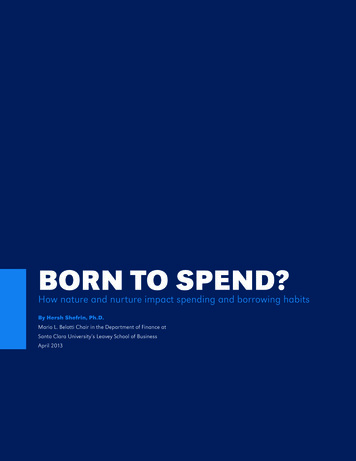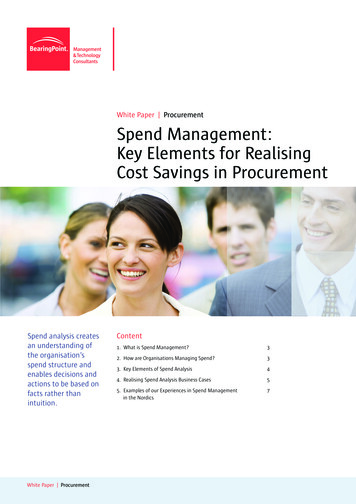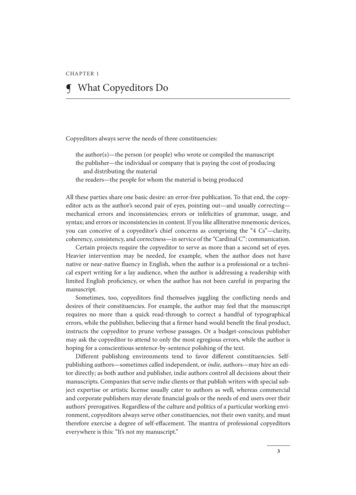
Transcription
BORN TO SPEND?How nature and nurture impact spending and borrowing habitsBy Hersh Shefrin, Ph.D.Mario L. Belotti Chair in the Department of Finance atSanta Clara University’s Leavey School of BusinessApril 2013
ACKNOWLEDGEMENTSHersh Shefrin, PhD is the Mario L. Belotti Chair in theDepartment of Finance at Santa Clara University’sLeavey School of Business. Born to spend? How natureand nurture impact spending and borrowing habitswas sponsored by Chase Blueprint.Page 2Born to spend? How nature and nurture impact spending and borrowing habits
go to table of contentsCONTENTSEXECUTIVE SUMMARY .41. INTRODUCTION .62. SPENDING AND BORROWING: WHAT WE KNOW ABOUT BEHAVIOR,LITERACY, AND PSYCHOLOGY .82.1. Behavior: National Financial Capability Study . 82.2. Literacy: Issues with Numeracy and Financial Education . 92.3. Psychology: Heuristics and Biases . 103. NATURE AND NURTURE .123.1. Nature: Hardwired Drivers of Spending and Borrowing . 123.2. Nurture Alongside Nature: What Data On Twins Tell Us . 143.3. Traditional Nurturing: Financial Education and Impact . 154. SMART NURTURING: BEHAVIORAL CHANGE AND CHOICE ARCHITECTURE .164.1. A Metaphor for Change . 164.2. Mental Accounting and Smart Nurturing . 164.3. Saving Money and Smart Nurturing . 174.4. Borrowing Less and Smart Nurturing . 185. INNOVATION, CONCRETE STEPS, AND SMART NURTURING: TIME TO TAKE ACTION .205.1 Harnessing Innovations in Smart Nurturing. 205.2. Harnessing Innovations in Technology . 215.3. Harnessing Innovations to Engage Young People . 225.4. Who Must Take Action? . 23CONCLUSION .24BIBLIOGRAPHY.26APPENDIX.30A.1. Characteristics of Heuristics. 30A.2. Smart Nurturing to Develop Good Spending Habits . 31A.3. Smart Nurturing to Develop Good Borrowing Habits. 34Page 3
EXECUTIVE SUMMARYIs it nature or is it nurture that matters when it comes to developing spendingand borrowing habits? And why does it matter?Many people have poor spending and borrowing habits, but what is the reason? Is it because they are genetically predisposedto make bad financial decisions or is it because they have poor financial literacy due to ineffective education? It is the classic“nature vs. nurture” question and, unsurprisingly, the answer is “it’s complicated.” Understanding what drives our financialbehavior is important because we know that strong financial literacy and good spending and borrowing habits are closelylinked. This paper explains the roles nature and nurture play when people make financial decisions. It also suggests steps thatwe can take to increase the level of mindful spending and borrowing.How our brains make financial decisions.There is evidence that nature plays the same role in financial decision-making, as it does in athletic ability. However, throughsmart nurturing, we can encourage people to make better choices when it comes to their money. Most decisions, includingdecisions about spending and borrowing, feature a combination of our habitual instincts known as fast thinking, and ourpurposeful and strategic thought processes utilized to override habits known as slow thinking. As with other habits, like smokingor overeating, it is difficult to overcome our fast thinking instincts, because our brains are hard-wired to resist the acceptance ofimmediate pain and the delay of gratification.The way our brains make decisions can be equated to a human rider atop an elephant. The elephant represents our habitual,fast thinking processes – things like walking, breathing, brushing our teeth, taking care of simple chores. The elephant is strongyet difficult to control. The rider on the other hand represents our “strategic” processes – activities like planning, list making,and other deliberate efforts to overcome our instincts. Often, people try to guide their behavior relying on rules of thumb,known as heuristics. However, our own biases lead to misjudgments often and put us on the wrong paths. The question we allwish to answer is: How do we overcome natural instincts and our habits to successfully equip our riders with skills to point theirelephants in the right direction?Why the traditional approach to financial literacy is not working.Traditional financial education has largely been ineffective in increasing our degree of financial literacy. The Jump tart Survey,which is administered every two years as a test to a stratified, random national sample of 12th grade students, demonstratesthe lack of progress being made. The survey revealed that students who took a high school class aimed at improving financialliteracy fared no better on the Jump tart test than those who did not take a class.Though some people are more inclined to make better financial decisions based on their genes (like people who arenaturally talented athletes), there are ways to train the brain into making smart spending and borrowing decisions.Current financial education does not take into consideration the importance of psychology and the knowledge of how ourbrains make decisions.Page 4Born to spend? How nature and nurture impact spending and borrowing habits
go to table of contentsSmart nurturing and how we can overcome poor spending and borrowing habits.The key to better financial literacy involves two tasks. The first is identifying what motivates us. The second is designing programsthat help people develop and maintain strong spending and borrowing patterns. Here are three ways to accomplish these tasks:Design smart nurturing programs that help people carry out the basics of managing spending and borrowing.Recent programs such as Save More Tomorrow (SMT) and Borrow Less Tomorrow (BLT) are examples of efforts usingpsychology to motivate people to make good decisions. Smart nurturing programs like these can involve easy motivatorssuch as setting goals, developing budgets, tracking expenses, identifying ways to increase income, choosing appropriatelenders, matching a person’s credit cards to their specific needs and paying balances down intelligently.Use modern technology, specifically personal financial management tools, to provide people with their spending datain a straightforward way that helps them acquire better habits. Collecting spending data can help consumers recognizespending patterns and correct bad behavior before it gets out of control.Turn finances into fun by using games to help instill better spending and borrowing habits in children, particularlyduring the K-12 years. Electronic games motivate students’ competitive instincts and activate the reward centers of theirbrains, all of which facilitate teaching them about mindful spending. The Jump tart Survey showed the most effectiveclassroom education was the stock market game. Why? Because it is interactive, contemporary, and fun. This presents anopportunity to introduce games into curriculum so that positive financial behavior becomes ingrained from the start.Who must take action?There is a high cost to bad financial decision making, which is why we need a collective effort to improve financial literacy.The private sector and the public sector, members of the media, educators, and individuals themselves can all play a role inimproving financial practices.Private sector firms, especially those in the financial sector, can harness innovations that help people make better decisionsabout their spending and borrowing. Financial service firms interact directly with consumers on a continuous basis, usetechnology extensively, and maintain repositories of data that make it possible to offer customized advice.The public sector can offer leadership by emphasizing the importance of improving financial behavior and financialcapability. Our elected leaders can promote policy changes and generate publicity around improving financial behaviorand financial literacy. The public sector can create centralized websites that provide users with techniques for managingtheir finances.Members of the media can look for interesting ways to attract attention to the importance of improving financial behaviorand innovative ways to spend and borrow mindfully.Educators can use games in the classroom to teach financial concepts in order to engage in smart nurturing. Moreover,as financial service firms and public sector entities successfully use smart nurturing techniques, educators can import thelessons learned into the classroom.We have the tools to improve financial capability.The existing efforts to promote sound financial decision-making, while well-intentioned, have not kept pace with whatpsychologists, economists and others know about how the human mind works. Now is the time to use this knowledge for acollaborative approach across public and private sectors to instill mindful spending and borrowing habits in our classroomsand beyond.Page 5
1INTRODUCTIONMany people have poor spending and borrowing habits – think of the shopaholic friendor the neighbor who is in debt. Every year, people looking to change their tendencies andhabits spend millions of dollars on therapy, guidance and self-help books. The reality is thatchanging behavior is difficult. Inertia is strong. The dieter looking to lose weight knows thisjust as well as the smoker looking to change his habits. On the other hand, some peoplefind it easy to change their ways. These people give up smoking easily, or are diligentwhen it comes to spending and borrowing habits. They keep tight budgets and use debtresponsibly. What is it that causes some people to demonstrate good behavior while othersnot as much? It is the age old question: is it nature or is it nurture?Unsurprisingly, the answer is “it’s complicated.” To help explainone of the drivers of our behavior and decision making, it is helpfulto think of a simple metaphor depicting a human rider atop anelephant. The elephant is powerful and has instincts of its ownabout where it wants to go, determined in large part by nature,and its current environment. In essence, the elephant is whatpsychologists refer to as our fast thinking processes—ourautomatic instincts that we do without thought. Much like anelephant, fast thinking can be hard to redirect and control.Unfortunately, for many people fast thinking does not leadto sound financial behavior.1WHAT IS IT THAT C AUSES SOME P E O P L ETO DEMONS TRATE GOOD B E H AV I O RWHILE OTHERS NOT A S M U CH ?IT IS THE AGE OLD QU E S T I O N :IS IT N AT URE OR IS IT NU RTU R E?The rider atop the elephant is much weaker than theelephant, but is more capable as a strategic planner. Therider equates to the slow thinking processes of our brains.Slow thinking is purposeful and takes effort. Setting specificgoals and spending in a deliberative fashion are actions thatentail slow thinking. People engage in slow thinking whenthey write grocery lists, plan vacations, choose colleges, andselect credit cards. Very often, slow thinking is learned.The question is: how do we get the rider to guide the elephant in the way that leads to the best outcomes? The great variabilityin behavior patterns for spending and borrowing is an established fact that we can take as given. What we cannot take as agiven is whether, and how, the variability in financial behavior or financial literacy stems from nature or nurture.Kahneman (2011) describes the psychological framework associated with thinking, fast and slow, where fast automatic fast thinking is denoted as System 1, anddeliberative slow thinking is denoted as System 2. The elephant and rider metaphor appears in Haidt (2006) and is further developed in Heath and Heath (2010).1Page 6Born to spend? How nature and nurture impact spending and borrowing habits
go to table of contentsThis paper has two main goals. The first goal is to document recent findings about the impacts of nature and nurture onhousehold spending and borrowing decisions. The second goal is to identify prescriptions to harness these and other innovationsin order to help people make better decisions about spending and borrowing.Studies from the last 15 years tell us that both nature andWE NEED TO ASK WHICH PEOP L E H AV Enurture impact financial management, which is why it isTHOSE COMPETENCIES, AND W H I CHvitally important to structure nurturing activities carefullyand thoughtfully when it comes to changing spending andDO NOT. AND F OR THOSE W H O D Oborrowing behavior. Economists believe that financial literacyNOT, WHAT KINDS OF INTERV E N T I O N Sis an important contributor to how well someone managesARE POSSIBLE THAT WOU L D H E L Ptheir spending and borrowing, yet recent research tells usTHEM MAKE BETTER DEC I S I O N S ?that the degree of financial literacy varies dramatically acrossindividuals. The degree of variation in behavior, especially for those with lower and middle incomes, cries out for a moredefined roadmap. The world is becoming more complex. The time is now to do something to help people.The central questions we need to ask about spending andborrowing begin with the basic financial competenciesindividuals require. We need to ask which people havethose competencies, and which do not. And for those whodo not, what kinds of interventions are possible that wouldhelp them make better decisions? In answering thesequestions we need to look to insights from behavioraleconomics about which nurturing activities are likelyto be effective and which are not. In short, we need tounderstand what smart nurturing entails! We need a betterroad map for how we address these important issues.Two goals of this paper:(1) Document recent findings aboutthe impacts of nature and nurtureon household spending andborrowing decisions.(2) Identify prescriptions to harnessthese and other innovations in orderto help people make better decisionsabout spending and borrowing.The remainder of this paper is organized into three financial sections that focus on different dimensions of spending and borrowing:Section 2 summarizes the current literature about financial behavior, literacy, and psychology.Section 3 discusses the roles played by nature and nurture.Section 4 describes a series of recommendations and concrete steps for both the public sector and private sector that canlead to improved financial behavior.An appendix describes suggestions for improving household spending and borrowing.Page 7
2SPENDING AND BORROWING:WHAT WE KNOW ABOUT BEHAVIOR,LITERACY, AND PSYCHOLOGY2.1. Behavior: National Financial Capability StudyEconomists have recently intensified their study of financial behavior and financial literacy,painting a clearer picture of how people manage their money. One of the best data sourcesto date comes from The National Financial Capability Study, commissioned by FINRA’sInvestor Education Foundation in consultation with the U.S. Department of the Treasury andthe President’s Advisory Council on Financial Literacy.2 The study consisted of three linkedsurveys conducted in 2009 and 2010:1.2.3.National telephone survey of 1,488 representative American adults;State-by-State Survey: online survey of approximately 25,000 American adults; andMilitary survey of 800 members of the military and/or their spouses.The National survey indicates that although people vary widelywhen it comes to making ends meet, a majority are challengedin this regard. Specifically, the survey found that more than halfof all Americans live paycheck-to-paycheck: 55 percent reportspending amounts that exceed or equal their household incomes.Approximately 60 percent of Americans have no “rainy day” fundto cover three months of unanticipated financial emergencies.During the previous five years, approximately 25 percent ofAmerican households engaged in high-cost, non-bank borrowing,such as taking out a payday loan or obtaining an advance on atax refund.The larger State-by-State survey, which reinforced the mainfindings from the National survey, provided a more focuseddemographic picture of the situation. The survey found thatcitizens of New York, New Jersey and New Hampshire were themost financially capable. At the other end, citizens of Kentuckyand Montana had the lowest financial capability. YoungAmericans nationally were less financially capable than olderAmericans, and engaged more frequently in non-bank borrowing.55%OF AMERICANS REPORT SPENDINGAMOUNTS THAT EXCEED OR EQUALTHEIR HOUSEHOLD INCOMES60%OFAMERICAN HOUSEHOLDS HAVENO “RAINY DAY” FUND25%OFAMERICAN HOUSEHOLDSARE ENGAGED IN HIGH-COST,NON-BANK BORROWINGSource: National Financial Capability Study commissionedby FINRA’s Investor Education Foundation2The information in this section is taken from FINRA’s website (http://www.finra.org/) and Lusardi (2010).Page 8Born to spend? How nature and nurture impact spending and borrowing habits
go to table of contentsThe Military survey is particularly interesting because members of the militaryTHE BOTTOM LINE F RO M A L Lwith financial difficulties cannot obtain high levels of security clearancesTHREE SURVEYS IS THAT M O R Ebecause of a concern that they are vulnerable in respect to espionage. Asa result, financially challenged members of the military are at a significantTHAN HALF OF AM E R I C A Ncareer disadvantage. The survey reports that approximately 25 percentHOUSEHOLDS M U D D L Eof service members are heavy carriers of credit card debt and/or reportT H ROUGH T H EIR FIN A NC ES.overdrawing their checking account balances, thereby incurring significantfees. Among enlisted personnel and junior non-commissioned officers surveyed, half of respondents reported that in somemonths, they made only the minimum payment on their credit cards. During the preceding five years, approximately 21percent used high-cost, non-bank borrowing such as payday or auto title loans. Finally, 50 percent maintain rainy day funds.Some portions of the military, such as the Navy, offer credit counseling. This might explain why members of the military appearto do better than their civilian counterparts in keeping up with monthly expenses, calculating how much they need to save forretirement, and checking their credit scores and credit reports.The bottom line from all three surveys is that more than half of Americans muddle through their finances and it is clear manyneed help making better decisions about spending and borrowing. They need help to better make ends meet. They need helpto better prepare financially for emergencies. They need help to take on less debt and reduce their borrowing costs when theydo borrow.2.2. Literacy: Issues with Numeracy and Financial EducationSince the late 1990s, economists have been documenting the degree to which the American people are financiallyliterate.3 Studies tell us that many people have difficulty understanding basic financial concepts about the terms andconditions of consumer loans and mortgages, and the characteristics of financial securities such as stocks and bonds.Moreover, many people over the age of fifty have issues with numeracy, meaning they find numbers challenging. The keyresearch shows that they are unable do simple interest-rate calculations, do not understand inflation, and have difficultywith the notion of risk diversification.We know there is a positive relationship between levels of household financial literacy and household financial behavior.4People with high levels of financial literacy are more likely to pay their bills on time, track expenses, set financial goals, engagein budgeting, pay credit card bills in full each month, maintain rainy day funds, save money from each paycheck, save forretirement, and hold diversified investment portfolios. In contrast, those with low levels of financial literacy are more likely toengage in negative credit behaviors such as debt accumulation, high-cost borrowing, mortgage delinquency and foreclosure.5Although we do not know for sure, it is tempting to think that we can improve financial behavior by improving financial literacy,which takes us to the issue of financial education. We know that some schools teach financial skills, although the extent isspotty. A 2007 report from the Networks Financial Institute at Indiana State University assessed the teaching of financial topicsnationally in K-12. The report documented that only about half of K-12 teachers indicated that they were teaching financialliteracy topics. Teachers that did not teach financial literacy cited three main reasons for not doing so, namely lack of time, lackof state curriculum requirements, and lack of demand.The relevant literature begins with the work of Bernheim (1995, 1998) who reported that American households displayed low levels of financial literacy. Seealso Moore (2003), Lusardi and Mitchell (2006, 2007, 2008).4Hilgert, et al. (2003) and Hastings, Madrian, and Skimmyhorn (2012).5Stango and Zinman (2008), Lusardi and Tufano (2009), Moore (2003), and Gerardi, et al. (2010).3Page 9
The Networks Financial Institute report indicated that teachers who did teach financialliteracy topics focused on three main areas: spending money, saving money, and budgeting.Teachers of K-5 focused on basics such as the difference between wants and needs in respectto spending and saving. Middle school teachers added budgeting and banking to thesetopics. High school teachers reinforced these topics and delved deeper into income, moneymanagement, and, most notably, borrowing.2.3. Psychology: Heuristics and Biases“HEURIS TI C S ” A R ERULES OF TH U M B TOMAKE TASK S M O R EMAN AGEAB L E , A N DGUIDE JUD G M E N T SAND DE C I SI O NS.As discussed in the introduction, an excellent metaphor for describing how our brains work is to imagine a human rider atop anelephant. To refresh your memory, the elephant is like our brain’s fast thinker. It is powerful and has instincts of its own aboutwhere it wants to go, determined in large part by nature, past nurturing activities, and the current environment. The rider is likethe slow thinker. The rider is much weaker than the elephant, but is more capable as a strategic planner.In this metaphor, our elephants have their favorite paths, routes they regularly and habitually take. These routes correspond tosimple “rules of thumb” that instinctively guide our behavior. Psychologists call these rules “heuristics.” People rely on heuristicsto make their tasks more manageable, and to guide their judgments and decisions.If our elephants’ heuristic paths were perfect, we would have no need to change. Unfortunately, our elephants, smart as manymay be, are prone to errors and misjudgments. Psychologists call these tendencies “biases.”The challenge our riders face is to identify biases wherever possible and find ways to direct our elephants to follow betterheuristics (paths). Consider what this means for spending and borrowing.Spending and borrowing are complex decisions, and there is considerable variation in spending and borrowing heuristics. Anexample of a spending heuristic is “buy strawberries if the price is less than 2 a pound.” An example of a borrowing heuristicis “always make at least the minimum monthly credit card payment and do not carry more than 500 as a balance.” Heuristicsoften feature “satisficing” behavior, which entails setting an aspiration level for what is good enough and using that aspirationas the basis for behavior. A person who sets 2 as her aspiration price for buying strawberries might set out to visit three storesselling groceries, and make the purchase at the first store she finds that sells them for 2 per pound or less. This is an exampleof a satisficing search rule.As a general matter, satisficing can lead to satisfactory outcomes. However, people who set their aspiration levels too low haveelephants that tend to stop the search too early. These people are biased in their belief that the outcome of their search willbe favorable. The evidence from the National Financial Capability Study indicates that people do indeed stop their searchestoo early. More than 60 percent of respondents indicated that they do not shop around for credit cards. Approximately half ofrespondents who obtained auto loans did not compare offers from different lenders. For those seeking a financial professional,more than 40 percent did not speak with more than one advisor. Moreover, more than 80 percent did not check on thebackground and credentials of that professional with a state or federal regulator.Respondents did engage in a more active search when it involved long-term contracts, mortgages being a primary example.Nevertheless, about one third of respondents with mortgages did not obtain offers from different lenders. Notably, thepeople who engage in the least comparison shopping tend to feature low incomes and low education.In a similar vein, many appear not to have sought information about their credit report and credit score. This is important,since credit scores are a critical determinant of the interest rates they will be charged on mortgages and loans. Yet, onlyapproximately 40 percent went to the trouble of obtaining a copy of their credit report and approximately 35 percent checkedtheir credit score. The ones who did seek out the information tended to be those with higher credit scores.Page 10Born to spend? How nature and nurture impact spending and borrowing habits
go to table of contentsAs already noted, numeracy is a problem for many people who do not understand the main terms of their financial contracts. Inthis regard, approximately 20 percent of people with auto loans do not know the interest rate on those loans. Approximately 10percent of those with mortgages do not know the interest rate on those mortgages. Slightly more than 45 percent of credit cardholders do not pay their full credit card balance each month, and approximately 15 percent appear to have exceeded their creditcard limit. Of the credit card holders who do not pay their full balance each month, 12 percent do not know the interest rate onthe credit card with the largest balance.Two of the most important biases are “excessive optimism” and “overconfidence.” Excessive optimism is the tendency tohave too rosy an outlook on life. Overconfidence about ability is the tendency to have an inflated idea of one’s ability. Peoplewho are excessively optimistic tend to be disappointed by outcomes more frequently than they anticipated. People who areoverconfident about their abilities tend to be unpleasantly surprised more frequently than they anticipated.Those who do not shop around for credit cards, do not compare offers from different lenders for auto loans, and only speakwith one financial advisor when seeking financial advice, act as if they are excessively optimistic. The cost of being excessivelyoptimistic and uninformed about borrowing options can be high. In respect to credit card behavior associated with explicit feesand finance charges, such as late payments, exceeding credit limits, using cash advances, and paying only the minimum, asmuch as one third of the charges and fees paid by those with low levels of financial literacy are effectively due to ignorance.In respect to overconfidence, one of the major findings of the National Financial Capability Study concerns self-perceptions offinancial knowledge. When asked to assess their financial knowledge, most respondents gave themselves high scores. Yet theevidence about a
The rider atop the elephant is much weaker than the elephant, but is more capable as a strategic planner. The rider equates to the slow thinking processes of our brains. Slow thinking is purposeful and takes effort. Setting speciÞc goals and spending in a deliberative fashion are actions that entail slow thinking. People engage in slow .










